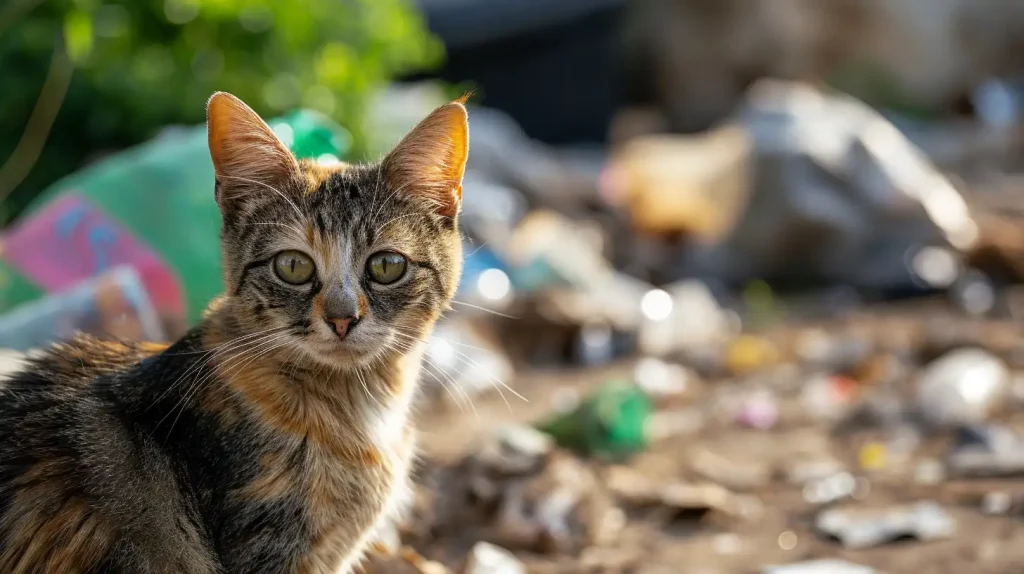Table of Contents
Stray cats can significantly impact waste management systems. They often scavenge in garbage bins and waste disposal areas, which can lead to the scattering of trash and make waste collection more challenging. Additionally, their presence might attract other wildlife to waste disposal sites, potentially exacerbating the issue of waste management.
Let’s discuss this topic in more detail in the paragraphs below…
Stray cats have long been a concern for communities across the United States. While they may seem harmless at first glance, their presence can have a significant impact on waste management in urban areas. From disrupting waste control systems to contributing to waste pollution, stray cats pose various challenges for waste management practices.
Key Takeaways
- Disruption of Waste Control Systems: Stray cats contribute to waste pollution by rummaging through garbage bins and trash containers, spreading waste and attracting other animals, which exacerbates the problem.
- Hindrance to Waste Disposal Efforts: Stray cats can cause blockages in trash chutes and compactors, leading to malfunction and downtime of waste management equipment.
- Impact on Litter Reduction Efforts: Stray cats tear open trash bags and scatter waste, which hinders litter reduction initiatives.
- Challenges in Managing Waste: Traditional waste management practices are less effective in the presence of stray cats, as they attract these animals and create additional messes.
- Potential Solutions: Solutions include using securely closed containers, cleaning areas around waste containers regularly, setting up designated feeding stations for stray cats, and implementing trap-neuter-return programs.
- Community Involvement: Educating residents about responsible pet ownership, implementing secure waste containers, and collaborative efforts between municipalities, waste management agencies, and animal welfare organizations are crucial.
- Comprehensive Approach Needed: Addressing the impact of stray cats on waste management requires a collaborative effort from communities, waste management professionals, and policymakers to find sustainable solutions that consider both community needs and environmental impact.
Understanding the Waste Management Issues Caused by Stray Cats
Stray cats have a significant impact on waste management in U.S communities. Their presence contributes to waste pollution and disrupts waste control systems, causing a range of waste management issues for communities to tackle.
One of the primary waste management issues caused by stray cats is their tendency to rummage through garbage bins and trash containers that are left outside, often spreading waste around the immediate environment. This not only results in unpleasant odors but also attracts other animals to the area, exacerbating the problem further.
Furthermore, stray cats can hinder waste disposal efforts by disrupting the collection process. They can cause blockages in trash chutes and trash compactors, which can lead to malfunction and downtime for essential waste management equipment.
Another waste management issue related to stray cats is their impact on litter reduction efforts. Stray cats frequently contribute to litter by tearing open trash bags and scattering waste around the area.

Managing Waste with Stray Cats: Challenges and Solutions
Managing waste with stray cats present can be challenging for communities. Traditional waste management practices that involve open containers or dumpsters can attract these animals, making it difficult to keep waste under control.
Another challenge is that stray cats often dig through waste, creating a mess that is hard to clean up. This not only makes the area unsightly but also contributes to the spread of disease.
However, there are solutions that communities can implement to manage waste effectively. One solution includes using containers with lids that can be securely closed, preventing stray cats from accessing the waste inside. Additionally, regularly cleaning the area around waste containers can deter cats from frequenting the area.
Communities can also consider setting up feeding stations for stray cats in designated areas away from waste containers. Doing so can help keep these animals fed and reduce the likelihood that they will search for food in waste containers.
Another solution involves working with local animal shelters or rescue organizations to implement trap-neuter-return programs. These programs can help reduce the number of strays in the community, which, in turn, can lead to a reduction in the waste generated by these animals.
It is important for communities to consider the challenges associated with managing waste when stray cats are present and to implement effective solutions to address this issue. By working together and employing various strategies, communities can manage their waste effectively while also addressing the needs of stray cats in their area.
The Impact of Stray Cats on Waste Reduction Efforts
Stray cats can have a serious impact on waste reduction efforts in communities. Waste disposal methods such as composting and recycling can be hindered by the presence of stray cats, who may rummage through and scatter the materials.
In addition, when cats urinate and defecate on recyclables such as cardboard and paper, it can render them unrecyclable and contribute to overall waste pollution. This can increase waste management costs and diminish the efficacy of waste reduction efforts.
Furthermore, the presence of stray cats may deter individuals from participating in waste reduction efforts, such as community clean-up events or litter reduction campaigns. This can result in a lack of engagement and momentum in addressing waste management challenges.
Addressing the issue of stray cats and their impact on waste reduction efforts requires a multifaceted approach. Communities can implement strategies such as secure waste disposal containers and compost bins that are inaccessible to stray cats. Additionally, community outreach and education on responsible pet ownership can help prevent the proliferation of stray cats in neighborhoods.
Furthermore, partnerships between animal welfare organizations and waste management authorities can help protect both the welfare of stray cats and the efficacy of waste reduction efforts. Working collaboratively means these organizations can develop solutions that address the root causes of stray cat populations while also prioritizing effective waste management practices.

Stray Cats and Waste Management: A Community Perspective
Stray cats can pose a significant challenge to waste management in communities. They often scavenge through trash cans and dumpsters, scattering waste across the streets and alleys. This not only makes the streets unsightly, but it also poses health risks to residents.
Communities often struggle with limited resources and options for managing waste with stray cats. Traditional waste management practices may not be effective in containing waste when stray cats are present, leading to increased costs for waste collection and disposal.
However, communities can play a vital role in addressing this problem. Educating residents about responsible pet ownership and the importance of spaying and neutering cats can help reduce the number of stray cats. Additionally, communities can implement measures such as secure waste containers, and dumpsters in designated areas or placing restrictions on feeding stray animals to reduce their population and the health and environmental risks associated with them.
Collaborative efforts between municipalities, waste management agencies, and animal welfare organizations can also help to establish comprehensive and effective waste management solutions that account for the presence of stray cats.
While managing waste with stray cats may present significant challenges, taking proactive measures can help mitigate the impact on communities and the environment.
The Impact of Stray Cats on Waste Management – Conclusion
Stray cats can have a significant impact on waste management in communities across the United States. As discussed in this article, the presence of stray cats can disrupt waste control systems, contribute to waste pollution, hinder waste reduction efforts, and present significant challenges to traditional waste management practices.
However, there are potential solutions to address these issues. For example, implementing community-based programs that focus on reducing the number of stray cats through spaying and neutering, as well as enforcing local laws that prohibit feeding and caring for stray cats in public areas, can be effective.
It is also important for communities to work together with waste management professionals to find sustainable solutions that incorporate both the needs of the community and the environment. For example, implementing waste management plans that take into account the presence of stray cats and their impact on waste disposal methods could be effective.
In conclusion, addressing the impact of stray cats on waste management requires a collaborative effort from communities, waste management professionals, and policymakers. By working together, we can find sustainable solutions that not only address the challenges of stray cats and waste management but also promote a cleaner and healthier environment for all.



